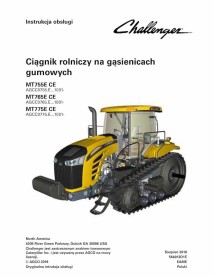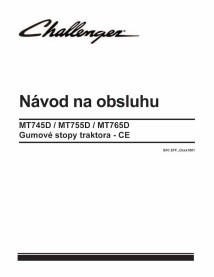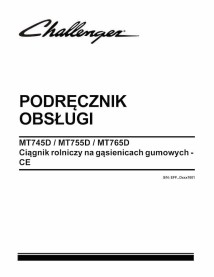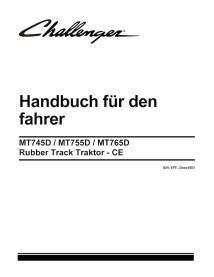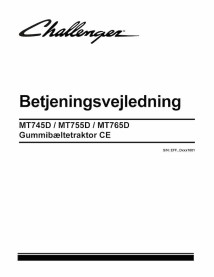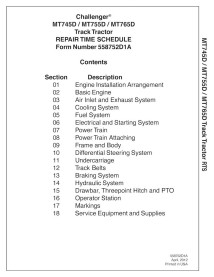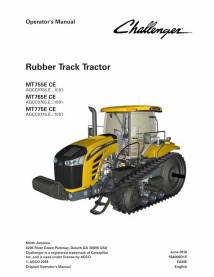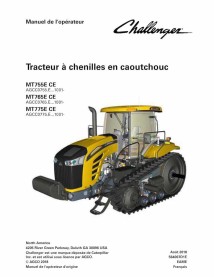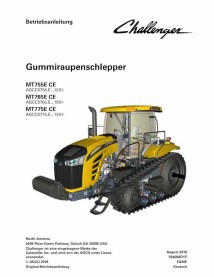CHALLENGER SERVICE, REPAIR AND OPERATOR'S MANUALS
Download service, workshop, repair and operator's manuals for Challenger combines, tractors, balers, sprayers, chassis, headers and other AGCO agriculture machines and equipment . PDF manuals previews available for free download. PDF manuals downloads available instantly after payment.
The Challenger brand of agricultural machinery has a long history of producing a wide range of farming equipment, including tractors, combines, sprayers, and other implements. The company was founded in the United States in 1986 and has since expanded to serve customers around the world.
Challenger machines are known for their advanced technology and innovative features, designed to help farmers maximize their productivity and efficiency. Many models feature advanced guidance systems that use GPS and other technologies to help farmers precisely control their operations and reduce waste.
Challenger machines are also known for their durability and reliability, with many models featuring heavy-duty construction and high-quality components designed to withstand the rigors of farming. They are often used in large-scale farming operations and are well-suited for working in tough conditions, such as uneven terrain or wet soil.
In terms of manuals, Challenger provides comprehensive documentation for all of its machines, including operator's manuals, maintenance manuals, and parts catalogs. These manuals provide detailed information on how to operate and maintain the equipment, as well as guidance on troubleshooting and repairs.
Operator's manuals typically include information on safety procedures, operating instructions, and basic maintenance tasks, such as checking fluid levels and replacing filters. Maintenance manuals provide more detailed guidance on maintenance tasks, including step-by-step instructions and recommended schedules for servicing various components. Parts catalogs list all the replacement parts available for the machine, including part numbers and prices.
Overall, Challenger machines and their associated manuals are designed to help farmers achieve maximum productivity and efficiency while minimizing downtime and maintenance costs.
Challenger is a brand of agricultural tractors, created by Caterpillar Inc.
In 1986 and sold to AGCO in 2002. The original model was the Challenger 65 featuring the Mobile-Trac System (MTS) consisting of rubber tracks and a suspension system. Although marketed as the world's first rubber-tracked agricultural tractor, East German Company VEB Traktorenwerk Schönebeck had produced a tracked tractor (the ZT 300 GB) since 1983. The MTS combined the flotation and traction of steel tracks with the versatility of rubber tires. The use of tracks gave the machines increased tractive performance compared to traditional four wheel drive tractors equipped with tires. The Challenger 65 began as a 270 gross HP machine used primarily for heavy tillage.
In 1995 Caterpillar introduced the first "row crop" tracked machines with the Challenger 35, 45 and 55. These machines ranged in power from 130 KW PTO to 168 KW and were designed to be used for a variety of tasks the larger machines could not. The Challenger tracked tractor was produced by Caterpillar at their Dekalb, Illinois location until the Challenger name and all of its associated agricultural assets were sold to AGCO.
Since 2002, when the brand was purchased by AGCO, Challenger tractors have been manufactured at the company's Jackson, Minnesota facility. At the time AGCO purchased the Challenger brand most Challenger dealers were also Caterpillar construction equipment dealers. Although AGCO has shifted focus of the Challenger tractor to the agricultural market, the construction market is still an important sector for the tractors as AGCO still manufactures specially configured machines for use with pull-type earth moving equipment.
The Caterpillar Challenger MT875B was the most powerful production tractor available during its span with 430 KW gross engine power. In 2007, the MT875B broke the world record for most land tilled in 24 hours with a custom-made, 14 m disc harrow fabricated by Grégoire Besson. It tilled 644 ha. The tractor consumed 4.42 liters/ha diesel fuel.
The current production of Challenger tractors has expanded to include both tracked and wheeled type tractors. Both types are available in either row-crop or flotation type configurations depending upon the preference of the customer. Since their purchase in 2002, the Challenger brand has used a Caterpillar diesel engine in the majority of their models. However, with the introduction of the D series of each tractor model, AGCO began implementing the use of AGCO POWER branded engines that are Tier 4i/Stage 3B emission compliant by using e3, a Selective Catalytic Reduction system which injects urea in engine's exhaust gas stream to reduce nitrogen oxides and particulate matter emitted to the atmosphere.
Current Models
- MT400B Series (discontinued)
- MT400D Series (discontinued) MT400E Series (utility)
- MT500D Series (discontinued)
- MT500E Series
- MT600D Series (discontinued)
- MT600E Series
- MT700C Series (discontinued)
- MT700D Series (discontinued)
- MT700E Series (discontinued)
- MT700 MT800C Series (discontinued)
- MT800E Series (2013-present)
- MT900C Series (discontinued)
- MT900E Series (2014-present)
- MT1000 Series (2017-present)
Search our site for the Challenger service manual you need.
Less
